Related Research Articles
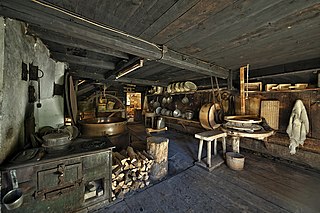
A dairy is a business enterprise established for the harvesting or processing of animal milk – mostly from cows or buffaloes, but also from goats, sheep, horses, or camels – for human consumption. A dairy is typically located on a dedicated dairy farm or in a section of a multi-purpose farm that is concerned with the harvesting of milk.
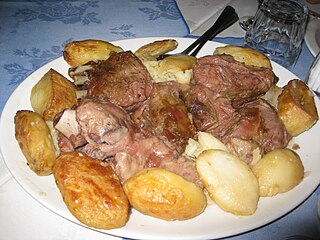
Lamb, hogget, and mutton, generically sheep meat, are the meat of domestic sheep, Ovis aries. A sheep in its first year is a lamb and its meat is also lamb. The meat from sheep in their second year is hogget. Older sheep meat is mutton. Generally, "hogget" and "sheep meat" are not used by consumers outside Norway, New Zealand, South Africa and Australia. Hogget is becoming increasingly commonly eaten in England, particularly in the North often in association with rare breed and organic farming.

Kumis Mongolian: айраг, ääryg) is a fermented dairy product traditionally made from mare's milk or donkey milk. The drink remains important to the peoples of the Central Asian steppes, of Turkic and Mongol origin: Kazakhs, Bashkirs, Kalmyks, Kyrgyz, Mongols, and Sakha. Kumis was historically consumed by the Khitan, Jurchen, Hungarians and Han Chinese of North China as well.
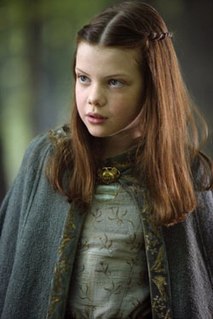
Lucy Pevensie is a fictional character in C. S. Lewis's The Chronicles of Narnia series. She is the youngest of the four Pevensie children, and the first to find the Wardrobe entrance to Narnia in The Lion, the Witch and the Wardrobe. Of all the Pevensie children, Lucy is the closest to Aslan. Also, of all the humans who have visited Narnia, Lucy is perhaps the one that believes in Narnia the most. She is ultimately crowned Queen Lucy the Valiant, co-ruler of Narnia along with her two brothers and her sister. Lucy is the central character of the four siblings in the novels. Lucy is a principal character in three of the seven books, and a minor character in two others.

Latvian Lauma or Lithuanian Laumė is a fairy-like woodland spirit, and guardian spirit of orphans in Eastern Baltic mythology. Originally a sky spirit, her compassion for human suffering brought her to earth to share our fate.

The cat-sìth, in Irish cat sí is a fairy creature from Celtic mythology, said to resemble a large black cat with a white spot on its chest. Legend has it that the spectral cat haunts the Scottish Highlands. The legends surrounding this creature are more common in Scottish folklore, but a few occur in Irish. Some common folklore suggested that the cat-sìth was not a fairy, but a witch that could transform into a cat nine times.

The Adventures of Prince Achmed is a 1926 German animated fairytale film by Lotte Reiniger. It is the oldest surviving animated feature film; two earlier ones were made in Argentina by Quirino Cristiani, but they are considered lost. The Adventures of Prince Achmed features a silhouette animation technique Reiniger had invented which involved manipulated cutouts made from cardboard and thin sheets of lead under a camera. The technique she used for the camera is similar to Wayang shadow puppets, though hers were animated frame by frame, not manipulated in live action. The original prints featured color tinting.

Tarot: Witch of the Black Rose is an American comic book, written and drawn by Jim Balent with coloring and lettering by Holly Golightly and published by Broadsword Comics since 1999.

"Donkey Cabbages" is a German fairy tale collected by the Brothers Grimm, tale number 122. A man shoots birds in a forest and gains magical objects. By also ingesting the heart of one of the bird he shot, he acquires an inexhaustible source of wealth. Later on, his magical abilities and items are stolen by a trio of witches, but regains thanks to a magical herb that causes a transformation into donkeys.

The Bideford witch trial resulted in hangings for witchcraft in England. Temperance Lloyd, Mary Trembles and Susannah Edwards from the town of Bideford in Devon were tried in 1682 at the Exeter Assizes at Rougemont Castle. Much of the evidence against them was hearsay, although there was a confession by Lloyd, which she did not fully recant even with her execution imminent. These women have been labelled as the last witches to be hanged in England, but there are subsequent cases which are not as well documented.
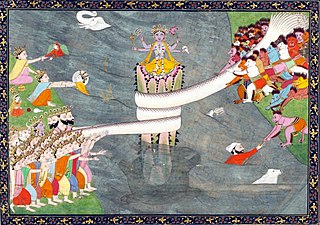
In Hindu cosmology, the Ocean of Milk is the fifth from the centre of the seven oceans. It surrounds the continent known as Krauncha. According to Hindu scriptures, the devas and asuras worked together for a millennium to churn the ocean and release Amrita the nectar of immortal life. It is spoken of in the Samudra manthana chapter of the Puranas, a body of ancient Hindu legends. It is called as Thirupaarkadal in Tamil and is the place where Vishnu reclines over Shesha Naga along with his consort Lakshmi.
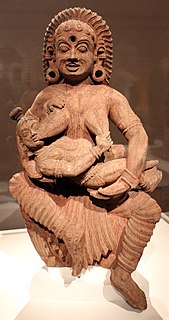
In Hinduism, Pūtanā is a rakshasi (demoness), who was killed by the infant-god Krishna. Putana disguises as a young, beautiful woman and tries to kill the god by breast-feeding poisoned milk; however Krishna sucks her milk as well as her life via her breasts. Putana is also considered as a foster-mother of Krishna as she breast-fed him. By offering her milk, Putana had performed "the supreme act of maternal devotion", in the shadow of her evil motives. The legend is told and retold in Hindu scriptures and some Indian books, which portray her variously as an evil hag or a demoness who surrendered herself to Krishna, though she initially came with evil motives.

Tylwyth Teg is the most usual term in Wales for the mythological creatures corresponding to the fairy folk of English and Continental folklore and the Irish Aos Sí. Other names for them include Bendith y Mamau, Gwyllion and Ellyllon.
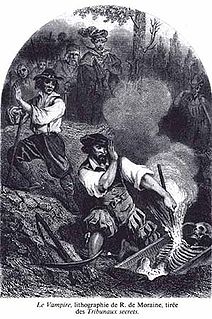
Legends of vampires have existed for millennia; cultures such as the Mesopotamians, Hebrews, ancient Greeks, and Romans had tales of demonic entities and blood-drinking spirits which are considered precursors to modern vampires. Despite the occurrence of vampire-like creatures in these ancient civilizations, the folklore for the entity known today as the vampire originates almost exclusively from early 18th-century Southeastern Europe, particularly Transylvania as verbal traditions of many ethnic groups of the region were recorded and published. In most cases, vampires are revenants of evil beings, suicide victims, or witches, but can also be created by a malevolent spirit possessing a corpse or a living person being bitten by a vampire themselves. Belief in such legends became so rife that in some areas it caused mass hysteria and even public executions of people believed to be vampires.

The Siberian Ice Maiden, also known as the Princess of Ukok, the Altai Princess, Devochka and Ochy-bala, is a mummy of a woman from the 5th century BC, found in 1993 in a kurgan of the Pazyryk culture in Republic of Altai, Russia. It was among the most significant Russian archaeological findings of the late 20th century. In 2012 she was moved to a special mausoleum at the Republican National Museum in Gorno-Altaisk.

Caroline Shawk Brooks was an American sculptor. Well known for her work sculpting in the medium of butter, she also worked with more traditional materials such as marble.
A troll cat is the familiar of a witch in Scandinavian folklore. Troll cats sucked milk from cows and spat it out in the witches' milk pails, and went into homes to lick up cream. Aside from cats, similar creatures include the milk rabbit, milk hare, and ball-shaped troll ball.
Séra Eiríkur Magnússon í Vogsósum, was an Icelandic priest and Galdrmaster. While he was a real person, he has been the subject of many folk tales because of his interest in and study in witchcraft. He is known in Icelandic folklore, where there are many folktales about his alleged magical abilities. He owned the farm Vogsósar, and was the vicar of Selvog church in the parish of Selvogur from 1677–1716. Some tales with him as the hero center on his magical duels with Stokkseyrar-Dísa. As a child he attended the Cathedral School at Skálholt to about 1658 and was ordained in 1668 by Bishop Brynjólfur Sveinsson as curate of Arnarboeli. He became the parish priest of Vogsósar in 1667.
Mary Butters was an Irish witch known as the Carnmoney witch.
Elspeth McEwen or McKewan or Elizabeth MacEwan of Balmaclellan was the most famous convicted witch in Galloway and the last to be burnt at the stake there. An elderly educated woman who lived alone, she was accused of tormenting her neighbours, for example by bewitching their poultry, causing hens, ducks or geese to stop laying, fall ill or die. She supposedly kept a wooden pin hidden in her rafters, which she used to steal milk from any cow by first touching the udder with the pin. In 1696 she was summoned to the local church session on charges of witchcraft. Among the proofs of her guilt was the evidence that the minister's mare, on which she rode to the session, was terrorised and sweated drops of blood.
References
- ↑ Simpson, Jacqueline (1972). Icelandic Folktales and Legends. London: Batsford. p. 174. ISBN 9780520021167. OCLC 464637195.
- ↑ Heurgren, Paul Gerhard (1925). Husdjuren i nordisk folktro (in Swedish). Örebro: Dagblads Tryckeri. p. 223. OCLC 1947125.
- ↑ Simpson, pp. 170–71.
- 1 2 3 4 Jón Árnason (1862–64), "Tilbera", Íslenzkar Þjóðsögur og Æfintýri (in Icelandic), Leipzig: Hinrichs, Netútgafan.
- ↑ Kvideland, Reimund; Sehmsdorf, Henning K. (1988). Scandinavian Folk Belief and Legend . Minneapolis: University of Minnesota. p. 179. ISBN 0816619670.
The snakkur was made from a dead man's rib, stolen wool, and communion wine.
- 1 2 3 Simpson, p. 171.
- 1 2 Simpson, p. 172.
- 1 2 3 Simpson, p. 173.